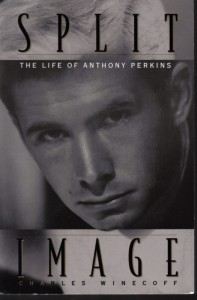
Charles Winecoff’s biography on the late, great slasher icon Anthony Perkins reveals the actor was much more complex, more troubled, and sometimes more crazed than any of the characters he portrayed. Now, out of respect to Perkins, I’m not going into all of the lurid details of his private life, but I will mention his drug use when it is relevant to his genre films.
When Anthony Perkins first arrived in Hollywood he dated Vampira and was groomed by the studios to be the next James Dean after Dean’s death. That didn’t work so studio bosses tried to make Perkins into an Elvis clone, a dual threat teen idol singer and actor. After Psycho made Perkins into a screen icon, the actor fled to Europe to escape Hollywood type casting. Despite working with legends like Orson Wells and Ingrid Bergman, Perkins could never duplicate his Psycho success and his film career began to flounder. The time in Europe stripped away Perkins’ boy-next-door charm which left his acting stiff and robotic.
Psycho II was Perkins big return to glory but he almost didn’t get the role because he demanded one million dollars to reprise Norman Bates. Universal was ready to give the part to Christopher Walken (!) so Perkins backed away from his high price tag. Another interesting bit of casting news revealed in Split Image is producers wanted Jamie Lee Curtis (double !) to play Marion Crane’s niece but Perkins and director Richard Franklin fought for Meg Tilly. During filming, however, Perkins would insult Tilly and tried to have her fired.
The sad truth about Perkins’ performances in Psycho II, Crimes of Passion, Psycho III, and Edge of Sanity is they were inspired by the drugs he ingested before takes. All of those nervous ticks and facials twitches were caused by either speed or amyl nitrate. Other times Perkins smoked pot and took LSD. While the drugs may have given his performance a dangerous edge, they also retarded his decision making abilities which severely damaged his directing skills. Psycho III and Lucky Stiff both suffered because Perkins was getting bombed out of his skull before he stepped on set to shoot a scene.
After he was diagnosed with AIDS in the early 1990’s, Perkins agreed to any part he could get his hands on in an attempt to leave his family financially stable after his death. For The Destroyer (a.k.a. The Shadow of Death) Perkins replaced Roddy McDowall on short notice, took an immediate dislike to costar Clayton Rohner, and ranted about Rohner’s poor acting performance to anyone that would listen. A Demon in My View and In the Deep Woods were the last films Perkins made before the illness left him bedridden and unable to breath. He had agreed to several other projects (a remake of the Mummy being the highest profile job) but died shortly after agreeing to appear in them.
Charles Winecoff’s Split Image: The Life of Anthony Perkins is an amazing read. This sometimes sad, sometimes funny, but often shocking account of Anthony Perkins life reveals more than you ever wanted to know about the first slasher star. Slasher fans will enjoy the stories concerning the making of Psycho and Perkins other slasher films. Interested fans shouldn’t have too much trouble tracking down a copy as a tenth anniversary expanded edition was published back in 2006. The new chapters deal with the death of Berry Perkins, Anthony’s widow, who was murdered by terrorist on 911.

5 Responses to Split Image: The Life of Anthony Perkins